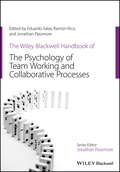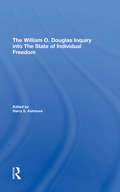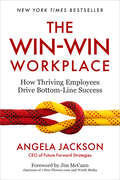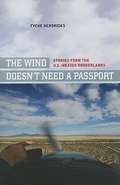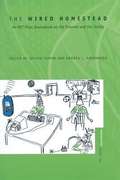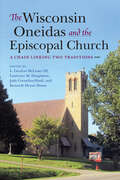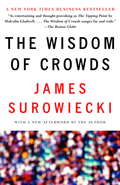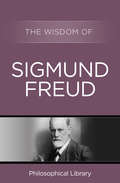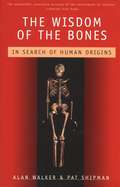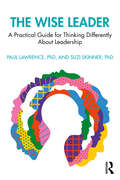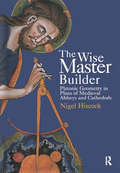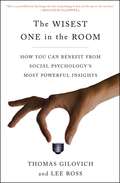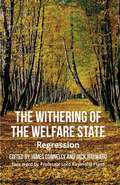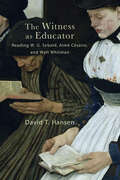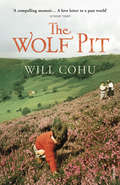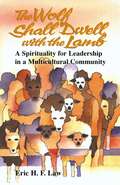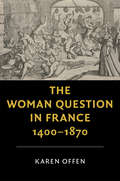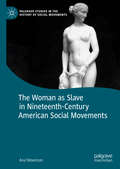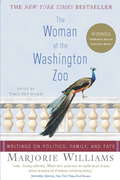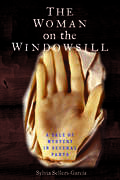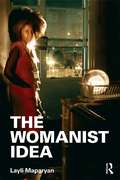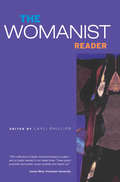- Table View
- List View
The Wiley-Blackwell Handbook of the Psychology of Team Working and Collaborative Processes
by Jonathan Passmore Eduardo Salas Ramon RicoA state-of-the-art psychological perspective on team working and collaborative organizational processes… This handbook makes a unique contribution to organizational psychology and HRM by providing comprehensive international coverage of the contemporary field of team working and collaborative organizational processes. It provides critical reviews of key topics related to teams including design, diversity, leadership, trust processes and performance measurement, drawing on the work of leading thinkers including Linda Argote, Neal Ashkanasy, Robert Kraut, Floor Rink and Daan van Knippenberg.
The William O. Douglas Inquiry Into The State Of Individual Freedom
by Harry S AshmoreThis volume, an inventory of aspects of individual freedom in a rapidly changing society bound by the Bills of Rights, is the result of a project of the Center for the Study of Democratic Institutions to monitor concerns of individual freedom that marked the career of Justice William O. Douglas.
The Willowbrook Wars: Bringing the Mentally Disabled into the Community
by David J. RothmanThe Willowbrook Wars is a dramatic and illuminating account of the effort to close down a scandal-ridden institution and return its 5,400 handicapped residents to communities in New York. The wars began in 1972 with Geraldo Rivera's televised raid on the Willowbrook State School. They continued for three years in a federal courtroom, with civil libertarian lawyers persuading a conservative and conscience-stricken judge to expand the rights of the disabled, and they culminated in a 1975 consent decree, with the state of New York pledging to accomplish the unprecedented assignment in six years.From 1975 to 1982, David and Sheila Rothman observed this remarkable chapter in American reform of mental disabilities care. Would the state live up to its agreement without "dumping" residents into other nightmarish institutions? Would the lawyers prove as interested in meeting client needs as in securing client rights? Could a tradition-bound bureaucracy create a new network of community services? And finally, would a governor and a legislature tolerate such outside intervention, and if so, for how long? In answering these questions,The Willowbrook Wars takes us behind the scenes to clarify the role of the judiciary, the fate of the underprivileged, and the potential for social justice. In their new afterword, the authors bring the story up to date, describing the results of the closing of the institution in 1987 from the experiences of integrating the former residents into communities to the legal battles between the state of New York and advocates for the mentally handicapped.
The Win-Win Workplace: How Thriving Employees Drive Bottom-Line Success
by Angela JacksonAn instant New York Times bestseller!Do you want the key to driving equity and skyrocketing profits? It's simple: hand over control to your workers.Discover 9 strategies to create better, healthier workplaces, grounded in evidence-based research.This revolutionary guide aims to revolutionize the workplace for justice, equity, and profitability by handing the reins over to the real drivers of success: the workers.Based on research from over 1,200 companies, including WalMart, Google, and JPMorgan Chase, this book follows real-world cases from companies where employees evolved from silent contributors to masterminds steering corporate strategies. These cases are the vanguard of a vibrant era in which workers will be the architects of their destinies, shaping not just their own careers but the entire trajectories of their organizations. Her work has quantified the financial impact investing in people can have on an organization- the first reliable calculation in the literature of talent retention. From this research, 9 key strategies emerged:•Centering employee voices•Mutualistic working relationships•Intersectional inclusion strategies•Reimaging employee benefits•Frontline leader driven strategies•Hire STARS•Develop deep talent benches•Human capital reporting as a competitive strategy•Distributed leadershipThis book goes deeper to show how these strategies are working in the real-world today. When workers have stakes, everyone scores: businesses surge, and teams ride a high they've never felt before. This is a win-win proposition: both management and labor win when you put people first.
The Wind Doesn't Need a Passport: Stories from the U. S. -Mexico Borderlands
by Tyche HendricksTyche Hendricks has explored the U.S.-Mexico borderlands by car and by foot, on horseback, and in the back of a pickup truck. She has shared meals with border residents, listened to their stories, and visited their homes, churches, hospitals, farms, and jails.
The Winding Passage: Sociological Essays and Journeys
by Daniel BellThis collection brings together Daniel Bell's best work in essay form. It deals with a variety of topics: technology and culture, religion and personal identity, intellectuals and their societies, and the uses and abuses of doctrines of social class. The Winding Passage demonstrates the author's continuing concern with the salient issues of our times, while its inspiration draws upon an older, humanistic sociological tradition.
The Winds of Ixtepeji: World View and Society in a Zapotec Town
by Michael KearneyThis anthropological case study deals primarily with the world view & social organization in the Zapotec town of Ixtepiji in the state of Oaxaca, Mexico.
The Wired Homestead: An MIT Press Sourcebook on the Internet and the Family
by Joseph Turow Andrea L. KavanaughThe use of the internet in homes rivals the advent of the telephone, radio, or television in social significance.
The Wisconsin Oneidas and the Episcopal Church: A Chain Linking Two Traditions
by L. Gordon McLester III, Laurence M. Hauptman, Judy Cornelius-Hawk, and Kenneth Hoyan HouseEssays exploring the relationship between the Wisconsin Native American tribe and the Episcopal clergy.This unique collaboration by academic historians, Oneida elders, and Episcopal clergy tells the fascinating story of how the oldest Protestant mission and house of worship in the upper Midwest took root in the Oneida community. Personal bonds that developed between the Episcopal clergy and the Wisconsin Oneidas proved more important than theology in allowing the community to accept the Christian message brought by outsiders. Episcopal bishops and missionaries in Wisconsin were at times defenders of the Oneidas against outside whites attempting to get at their lands and resources. At other times, these clergy initiated projects that the Oneidas saw as beneficial—a school, a hospital, or a lace-making program for Oneida women that provided a source of income and national recognition for their artistry. The clergy incorporated the Episcopal faith into an Iroquoian cultural and religious framework—the Condolence Council ritual—that had a longstanding history among the Six Nations. In turn, the Oneidas modified the very form of the Episcopal faith by using their own language in the Gloria in Excelsis and the Te Deum as well as by employing Oneida in their singing of Christian hymns.Christianity continues to have real meaning for many American Indians. The Wisconsin Oneidas and the Episcopal Church testifies to the power and legacy of that relationship.
The Wisdom of Crowds: Why The Many Are Smarter Than The Few And How Collective Wisdom Shapes Business, Economies, Societies And Nations
by James SurowieckiIn this fascinating book, New Yorker business columnist James Surowiecki explores a deceptively simple idea: Large groups of people are smarter than an elite few, no matter how brilliant—better at solving problems, fostering innovation, coming to wise decisions, even predicting the future. With boundless erudition and in delightfully clear prose, Surowiecki ranges across fields as diverse as popular culture, psychology, ant biology, behavioral economics, artificial intelligence, military history, and politics to show how this simple idea offers important lessons for how we live our lives, select our leaders, run our companies, and think about our world.
The Wisdom of Sigmund Freud (Wisdom)
by The Wisdom SeriesAn invaluable guide to Freud&’s terminology and work. Repression, ego, analysis, neurosis—the language of psychology permeates our modern vocabulary. The brilliant observations of Sigmund Freud form not only the basis for psychoanalysis but also much of our current understanding of the human condition. This essential and approachable guide offers an A-to-Z glossary of terminology defined in Freud&’s own words, including his diagnostic and treatment recommendations as well as his well-known works, including dream interpretation, the Oedipal complex, and the practice of psychoanalysis. This ebook features a new introduction, image gallery, and index of the Hebrew alphabet.
The Wisdom of the Bones: In Search of Human Origins
by Pat Shipman Alan WalkerTell the story of that epochal find and reveal what it tells us about our earliest ancestors. We learn that Nariokotome boy was a highly social predator who walked upright but lacked the capacity for speech. The Wisdom of the Bones also offers an engaging chronicle of the hundred-year-long search for a "missing link," a saga of folly, heroic dedication, and inspired science.
The Wise Leader: A Practical Guide for Thinking Differently About Leadership
by Paul Lawrence Suzi SkinnerThe Wise Leader offers readers a succinct perspective on wise leadership based on theory, practice, and the authors’ own experience. The five sections of the book describe the Wise Leader model, five mantras that distil the essence of wisdom for leading. Each section has a theoretical component, theory that the authors seek to bring to life through everyday examples, followed by practical ideas and guidance as to what you can next do in service of becoming a wiser, more effective leader. Each mantra then includes fresh perspectives for leadership development, aimed at supporting organisations globally to maximise their considerable investment in this critical area. This book is written for leaders at every level of an organisation, providing a perspective of wise leadership that lends itself to practical application. It can also be used by leadership development professionals, offering guidance on how to build practical programs to cultivate enhanced levels of wise leadership in your organisation.
The Wise Master Builder: Platonic Geometry in Plans of Medieval Abbeys and Cathederals (Routledge Revivals Ser.)
by Nigel HiscockThis title was first published in 2000: Did the plan of medieval churches have any underlying symbolic meaning? This work re-opens the debate about the importance of geometry and symbolism in medieval architectural design and argues the case for attributing an intellectual meaning to the planning of abbeys and cathedrals. In challenging prevailing claims for the use of arithmetical rations in architectural design, notably those based on the square root of two, Dr Hiscock advances a perspective consisting of proportions derived from the figures of Platonic geometry - the square, the equilateral triangle and the pentagon - and provides evidence for the symbolic interpretation of these figures. The investigation further reveals whole series of geometric relationships between some of England's most celebrated Norman cathedrals, such as Norwich or Durham, together with a wide sample from the Continent, from Old St Peter's in Rome to Chartres Cathedral, and sets out a comprehensive design method in each case. Hiscock first demonstrates the proposition that the ideas of Christian Platonism, including number and geometry, remained current and were employed in the thought of the early Middle Ages. In particular, he argues that they can be associated with the leading persons in the 10th-century revival of monasticism and that they found expression in the "white mantle of churches" that spread across Western Europe at the end of the first millennium AD. The book then provides a detailed analysis of the geometric proportions of church plans between the 9th and 12th centuries in Germany, France and in England. This research seeks to demonstrate that a coherent sequence of geometric forms can be seen in thse plans, forms which correspond to the key figures of Platonic geometry as understood in the context of Christian Platonist thought. In conclusion, the author shows how the system of design proposed could be set out on site using the known working methods of medieval masons.
The Wisest One in the Room
by Thomas Gilovich Lee RossRenowned psychologists describe the most useful insights from social psychology that can help make you "wise": wise about why people behave the way they do, and wise about how to use that knowledge in understanding and influencing the people in your life.When faced with a challenge, we often turn to those we trust for words of wisdom. Friends, relatives, and colleagues: someone with the best advice about how to boost sales, the most useful insights into raising children, or the sharpest take on an ongoing conflict. In The Wisest One in the Room, renowned social psychologists Thomas Gilovich and Lee Ross ask: Why? What do these people know? What are the foundations of their wisdom? And, as professors and researchers who specialize in the study of human behavior, they wonder: What general principles of human psychology are they drawing on to reach these conclusions? They begin by noting that wisdom, unlike intelligence, demands some insight into people--their hopes, fears, passions, and drives. It's true for the executive running a Fortune 500 company, the candidate seeking public office, the artist trying to create work that will speak to the ages, or the single parent trying to get a child through the tumultuous adolescent years. To be wise, they maintain, one must be psych-wise. Gilovich and Ross show that to answer any kind of behavioral question, it is essential to understand the details--especially the hidden and subtle details--of the situational forces acting upon us. Understanding these forces is the key to becoming wiser in the way we understand the people and events we encounter, and wiser in the way we deal with the challenges that are sure to come our way--perhaps even the key to becoming "the wisest in the room."
The Withering of the Welfare State
by James Connelly Jack HaywardSince the 1970s the public commitment to social solidarity between citizens through comprehensive provision of welfare has been eroded by the imperatives of international markets. In this volume the problems posed to public intervention are analyzed. The contributors compare and evaluate how different countries have dealt with these challenges.
The Witness as Educator: Reading W. G. Sebald, Aimé Césaire, and Walt Whitman
by David T. HansenIlluminates the power in bearing witness as an ethical orientation toward the world and its people.In The Witness as Educator, David T. Hansen examines the idea of bearing witness. He shows how it constitutes an ethical orientation that heeds human yearnings for justice, beauty, and meaning. He engages the work of three exemplary witnesses: W. G. Sebald, Aimé Césaire, and Walt Whitman. Sebald powerfully confronts the human costs of the violence of the nineteenth and twentieth centuries. Césaire evokes a creative Black consciousness in the face of European colonialism and attests to this outlook's joyous and painful development. Whitman's witness to American life, alongside his poignant testimony about caring for wounded soldiers during the American Civil War, speaks to a hope deeper than hope for the prospects of democracy. Hansen shows how these witnesses did not "choose" to write about their respective themes. They had to. The circumstances of their lives and the events of their time summoned them to bear witness. Hansen addresses how their efforts, supplemented by those of other witnesses whose testimony he incorporates, hold considerable educational promise in a world marked by continued misunderstanding and discord and yet also by great possibility.
The Wolf Pit
by Will CohuIn 1966 Will Cohu's grandparents moved to Bramble Carr, a remote cottage on the Yorkshire moors. The summers and winters he spent there were full of freedom and light; only after childhood ended was he aware of the price the adults had paid for life in this most romantic of settings.Navigating family tensions and the trials of growing up, Will describes the close-knit community of North Yorkshire and his family's place within it: the shepherd probing the head-high snowdrifts for his flock; the pub landlord obsessed with military uniforms; the village doctor lost in his love for the purple moorland; Will's glamorous RAF parents; and, at the centre of the story, his beloved but enigmatic grandparents.The Wolf Pit is an enquiring love letter from Will Cohu to his family, and to a changing rural England that is passionate, frightening and funny.
The Wolf Shall Dwell with the Lamb: A Spirituality for Leadership in a Multicultural Community
by Eric H. F. LawThis groundbreaking work explores how certain cultures consciously and unconsciously dominate in multicultural situations and what can be done about it.
The Woman Question in France, 1400–1870 (New Studies in European History)
by Karen OffenThis is a revolutionary reinterpretation of the French past from the early fifteenth century to the establishment of the Third Republic, focused on public challenges and defenses of masculine hierarchy in relations between women and men. Karen Offen surveys heated exchanges around women's 'influence'; their exclusion from 'authority'; the increasing prominence of biomedical thinking and population issues; concerns about education, intellect, and the sexual politics of knowledge; and the politics of women's work. Initially, the majority of commentators were literate and influential men. However, as more and more women attained literacy, they too began to analyze their situation in print and to contest men's claims about who women were and should be, and what they should be restrained from doing, and why. As urban print culture exploded and revolutionary ideas of 'equality' fuelled women's claims for emancipation, this question resonated throughout francophone Europe and, ultimately, across the seas.
The Woman as Slave in Nineteenth-Century American Social Movements (Palgrave Studies in the History of Social Movements)
by Ana StevensonThis book is the first to develop a history of the analogy between woman and slave, charting its changing meanings and enduring implications across the social movements of the long nineteenth century. Looking beyond its foundations in the antislavery and women’s rights movements, this book examines the influence of the woman-slave analogy in popular culture along with its use across the dress reform, labor, suffrage, free love, racial uplift, and anti-vice movements. At once provocative and commonplace, the woman-slave analogy was used to exceptionally varied ends in the era of chattel slavery and slave emancipation. Yet, as this book reveals, a more diverse assembly of reformers both accepted and embraced a woman-as-slave worldview than has previously been appreciated. One of the most significant yet controversial rhetorical strategies in the history of feminism, the legacy of the woman-slave analogy continues to underpin the debates that shape feminist theory today.
The Woman at the Washington Zoo: Writings on Politics, Family, and Fate
by Marjorie WilliamsOne of Washington's finest writers on people, politics, and life ? collected for the first time.
The Woman on the Windowsill: A Tale of Mystery in Several Parts
by Sylvia Sellers-GarciaA true story of violence and punishment that illuminates a transformative moment in Guatemalan history On the morning of July 1, 1800, a surveyor and mapmaker named Cayetano Díaz opened the window of his study in Guatemala City to find a horrific sight: a pair of severed breasts. Offering a meticulously researched and evocative account of the quest to find the perpetrator and understand the motives behind such a brutal act, this volume pinpoints the sensational crime as a watershed moment in Guatemalan history that radically changed the nature of justice and the established social order. Sylvia Sellers-García reveals how this bizarre and macabre event spurred an increased attention to crime that resulted in more forceful policing and reflected important policy decisions not only in Guatemala but across Latin America. This fascinating book is both an engaging criminal case study and a broader consideration of the forces shaping Guatemala City at the brink of the modern era.
The Womanist Idea
by Layli MaparyanFollowing on the heels of The Womanist Reader, The Womanist Idea offers a comprehensive, systematic analysis of womanism, including a detailed discussion of the womanist worldview (cosmology, ontology, epistemology, logic, axiology, and methodology) and its implications for activism. From a womanist perspective, social and ecological change is necessarily undergirded by spirituality – as distinct from religion per se – which invokes a metaphysically informed approach to activism.
The Womanist Reader: The First Quarter Century of Womanist Thought
by Layli PhillipsComprehensive in its coverage, The Womanist Reader is the first volume to anthologize the major works of womanist scholarship. Charting the course of womanist theory from its genesis as Alice Walker’s African-American feminism, through Chikwenye Okonjo Ogunyemi’s African womanism and Clenora Hudson-Weems’ Africana womanism, to its present-day expression as a global, anti-oppressionist perspective rooted in the praxis of everyday women of color, this interdisciplinary reader traces the rich and diverse history of a quarter century of womanist thought. Featuring selections from over a dozen disciplines by top womanist scholars from around the world, plus several critiques of womanism, an extensive bibliography of womanist sources, and the first ever systematic treatment of womanist thought on its own terms, Layli Phillips has assembled a unique and groundbreaking compilation.
